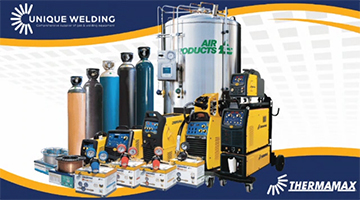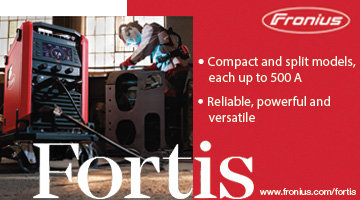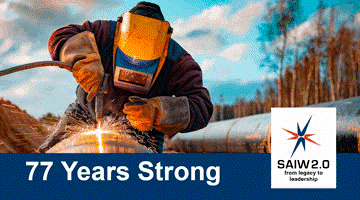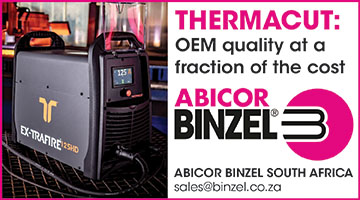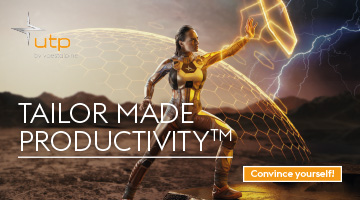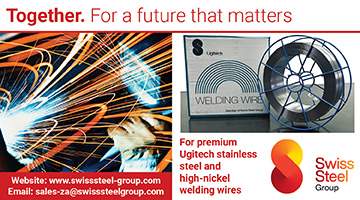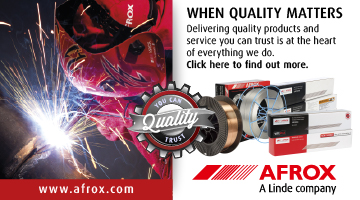Air Products Welding Specialist, Sean Young, offers expert advice on optimising the selection of shielding gases for welding and the effect this choice has on arc stability, weld quality, spatter and clean up requirements and, ultimately, total welding costs.
Click to download and read pdf
Manufacturing costs have increased significantly in the past few years because of a number of external factors. The current challenge for manufacturers is to manage the costs involved in welding processes without compromising quality, output volumes or production rates. One way to manage these costs is to ensure that the correct materials, processes and consumables are used from the onset, to avoid unnecessary costs as a result of unsuccessful welds that require rework.

For a fusion weld to be successful, the molten welding consumable and the metal components being joined all need to be protected from oxidation and atmospheric contamination. This can be achieved by means of a flux – when a stick electrode of self-shielded wire consumable is being used, for example – or by using a shielding gas. In the case of shielding metal arc (SMA) electrodes or submerged arc processes, a flux is used, whereas a gas shield is used with gas metal arc welding (GMAW), gas tungsten arc welding (GTAW) and most flux-cored processes.
Selecting optimised shielding gas mixtures for gas metal arc welding (GMAW) of carbon steel is one way in which costs can be evaluated and minimised. For Air Products, it is important to provide customers with different solutions that suit their specific needs, and assist with cost savings where possible.
“Air Products offers specialist services and advice to customers on various components of the process, one of which is the selection of shielding gas,” says Young, adding that it is important to look at the welding process, the material, its thickness and the metal transfer mode before selecting the combination of associated consumables that will produce a quality weld that is also cost effective in terms of the project.
“Resulting weld properties are significantly affected by the shielding gas used and in order to optimise the choice of shielding gas, it is important to take all the elements into account that can affect the quality of the weld, such as spatter, bead profile, fusion and penetration,” Young notes.
Air Products offers a wide variety of shielding gases and mixtures and a number of commonly used ones for welding are:
CO2, which is largely used for GMAW of carbon steels in dip transfer mode.
Argon: suitable for GMAW of non-ferrous materials and all GTAW applications.
Argon/CO2, Argon/O2, Argon/CO2/O2 mixes are used for GMAW of carbon steels as well as stainless steels.
In the case of more advanced GTAW applications, mostly for more exotic materials and critical applications, argon/helium and argon/hydrogen mixes are available.
With more advanced and specialised GMAW applications, Argon/He/CO2 and Argon/H2/CO2 mixes are available
Elaborating on the use of argon and CO2 gases, Young says: “In any mixed shielding gas cylinder, argon is generally the dominant gas. In its pure form, it is an inert gas that is used to keep other gases out and has no chemical effect on the deposited metal weld. On its own, argon is used for all tungsten inert gas welding (GTAW/TIG) and GMAW aluminium and copper and its alloys.”
He further explains that pure CO2 is perceived as the original shielding gas for GMAW and is still commonly used for general purpose welding of steels today. It is widely regarded as a least-cost shielding gas. However, because CO2 violently dissociates into carbon monoxide and oxygen in the arc, it can destabilise the arc and cause spatter. The dissociation leads to a hotter arc with deep penetration, but it also causes large droplet formation and unstable metal transfer, which is known to restrict the use of the CO2 to the dip-transfer mode.
Improving welds with active gas additions
Minority percentages of active gases such as oxygen and carbon dioxide can make significant improvements to an argon-based shielding gas for GMAW of carbon steels and stainless steels. “Adding small percentages of oxygen leads to a shielding gas with improved wetting action and it also decreases the surface tension of the molten metal, producing a flatter weld. Furthermore, the pinch-off effect is accelerated, creating smaller sized droplets. The result is more stable metal transfer, a softer arc and reduced spatter,” says Young.
Improved transfer stability ensures that the GMAW welding process is less sensitive to welding parameters and more tolerant to voltage and current variation. Ultimately, this leads to reduced time for machine set-up, which improves overall productivity. He adds that an argon/oxygen mixture with up to 2% oxygen is ideal for stainless steel applications.
In instances where CO2 is added to argon in a two-part mix, there is an improvement in the penetration of carbon steel joints. A limit in the percentage CO2 plays a role in obtaining smooth metal transfer in the spray transfer mode and to overcome instability issues.
According to Young, improved penetration and welding speed is obtained when increasing the CO2 as a result of the increase in temperature in the welding arc. He warns, however, that more than 15% CO2 in an argon-based mixture causes spatter and instability to re-emerge. “A mix of about 15% CO2 in argon is optimal but, in the case of thinner materials where penetration is not required, 3% CO2 and 97% Ar is sufficient,” he suggests.
The benefits of three part mixes
GMAW shielding gas mixtures can be further optimised to provide the best welding properties for particular applications by combining the benefits of CO2, O2 and argon.
Elaborating on three part mixtures, Young says: “Such mixtures generally consist of argon with CO2 of up to 15% and O2 of up to 3%. By using all three gases, it becomes possible to further improve arc stability, while optimising metal transfer characteristics, minimising spatter generation and improving penetration and the bead profiles”.
He explains that there is a vast difference between two part and three part mixtures, in particular when you look at the spatter generated during the welding process – three part mixtures tend to generate far less spatter. “In the long run, welding costs accumulate when the time and costs of post-weld activities and cleaning up are taken into consideration. A slightly more expensive gas mixture might make a switch worthwhile if an accurate cost comparison is done,” he argues.
There are numerous other benefits of using three part mixtures: increased quality, ease of use and better welding stability, which becomes more tolerant to variations in parameter settings. All of these factors can result in improved profitability, productivity and efficiency.
“Improving welding stability plays a major role in total welding costs. For example, when drawing a direct comparison between a two part argon/CO2 mix and Air Products’ MagMix3 three part mix with CO2 in the 5% range, the welding time for a 30 cm weld was reduced from 58 to 48 seconds. This translates into a 20% increase in welding speed, with reduced post-weld grinding, less spatter and a cleaner look as bonuses,” Young notes.
Air Products SA manufactures, supplies and distributes a diverse portfolio of atmospheric gases, specialty gases, equipment and services to the Southern African region. The company touches the lives of consumers in positive ways every day, and serves customers across a wide range of industries from food and beverage, mining and petrochemicals, primary metal and steel manufacturers, welding and cutting applications to laboratory applications.
Founded in 1969, Air Products South Africa has built a reputation for its innovative culture, operational excellence and commitment to safety, quality and the environment. In addition the company aims to continue its growth and market position in the Southern African region.
Air Products strives to assist customers in streamlining processes with solutions to increase production and productivity. As the welding specialist, Sean Young is able to do this by providing expert advice on all of the alternative options available to customers when selecting gases for particular welding applications and processes.



